Ko Lanta is an island located in the Andaman Sea, in the southern part of Thailand. The island is known for its breathtaking beaches, clear waters, and lush greenery.
One of the island’s less talked about, yet equally fascinating features, is its diverse bird population. From colorful kingfishers to the majestic sea eagles, Ko Lanta is a haven for birdwatchers.
While some of the birds cannot be seen anywhere else in Thailand, others are common to the region. With a range of habitats, from mangroves to forests, Ko Lanta offers a unique experience for bird enthusiasts looking to explore the island’s avian diversity.
1. Common Kingfisher
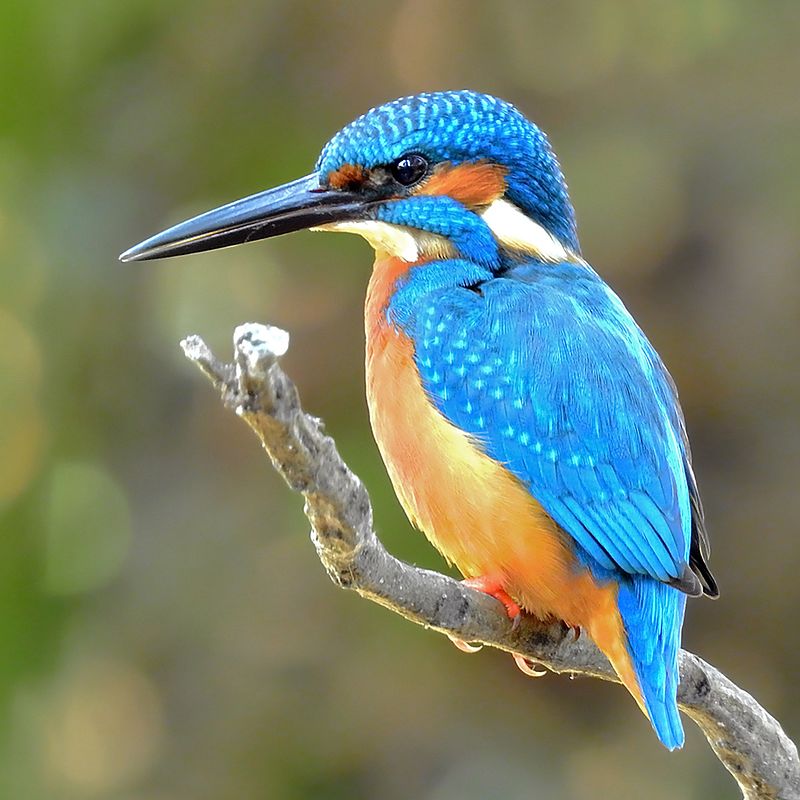
The Common Kingfisher is a small, sparrow-sized bird that can be found across Eurasia and North Africa. It has the typical short tail and large head of kingfishers with seven different subspecies recognized in its range.
They are mainly resident birds but will migrate away during winter when rivers freeze over. The species usually live near bodies of water such as streams or lakes.
Where they hunt for fish by diving from above into the water after spotting their prey below them.
These brightly coloured birds have an unmistakable vibrant blue plumage along with orange underparts and white patches on their wings which makes them easy to recognize amongst other similar looking species.
Their call is loud and shrill making it one of the most recognizable sounds heard around wetlands throughout Europe.Scientific classification:
| Kingdom | Animalia |
| Phylum | Chordata |
| Class | Aves |
| Order | Coraciiformes |
| Family | Alcedinidae |
| Subfamily | Alcedininae |
| Genus | Alcedo |
| Species | A. atthis |
Also Featured In: Common Birds in India, Ukrainian Birds You Should Know
2. Green-Billed Malkoha
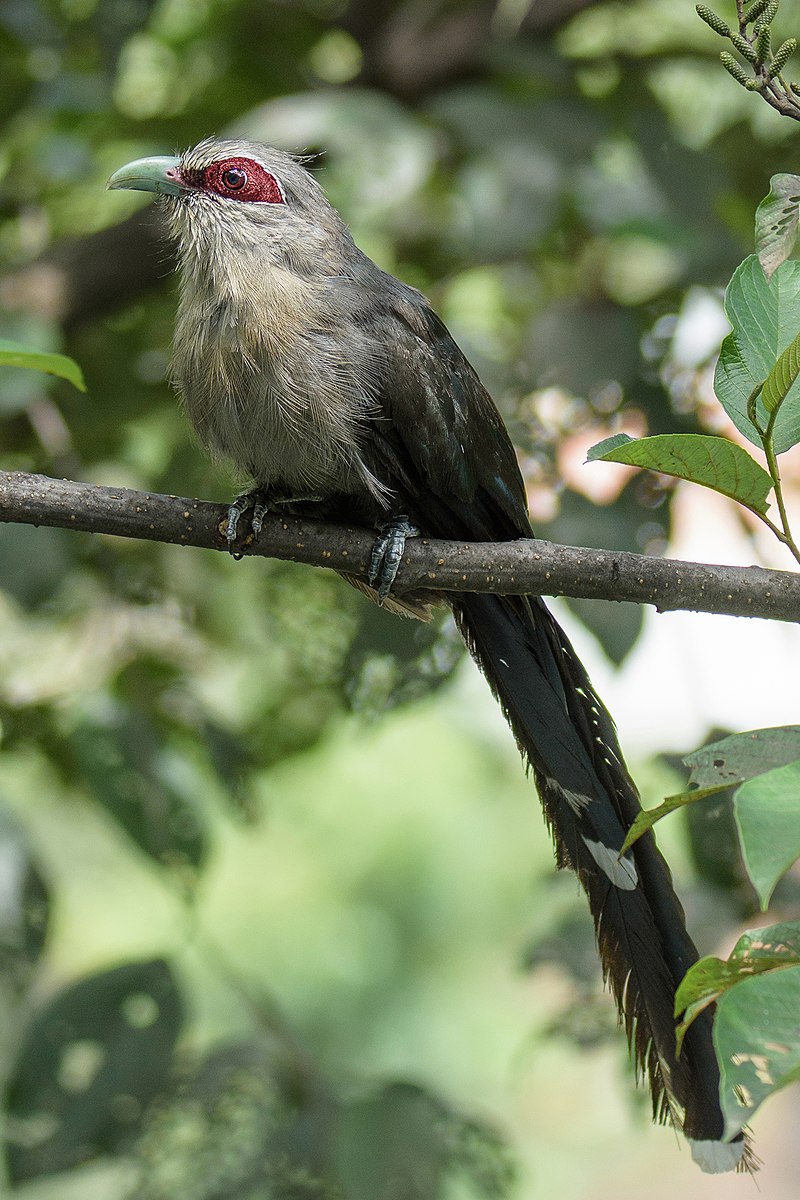
The Green-billed Malkoha is a striking bird found across the Indian Subcontinent and Southeast Asia. It measures 50 to 60 cm in length, with a waxy bluish black body and long graduated tail featuring white tips on its feathers.
The most remarkable feature of this species is its prominently curved green bill, which gives it name. These birds are usually seen in dry scrub or thin forest habitats.
They feed mainly on insects such as grasshoppers, caterpillars and beetles that they hunt by perching before swooping down to capture their prey.
In addition to hunting for food, these birds also nestle into trees during the day time when it gets too hot outside.
Weighing around 100 gmms, Green-Billed Malkohas make an interesting sight wherever they go due to their unique appearance.Scientific classification:
| Kingdom | Animalia |
| Phylum | Chordata |
| Class | Aves |
| Order | Cuculiformes |
| Family | Cuculidae |
| Genus | Phaenicophaeus |
| Species | P. tristis |
Also Featured In: Birds That You’ll See in Kaziranga National Park, Birds of Andhra Pradesh
3. Spotted Dove
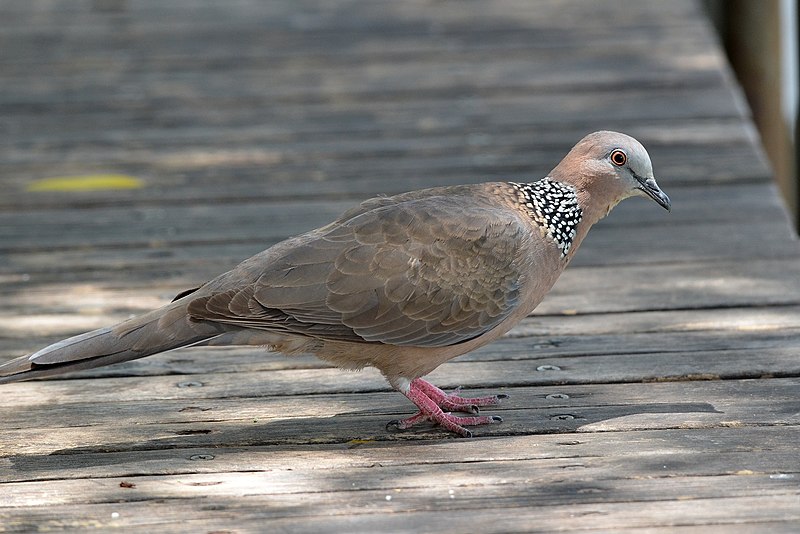
The Spotted Dove is a common species of pigeon found in the Indian subcontinent and Southeast Asia. It has an elegant, slender body with small head, long tail feathers and spotted wings.
Its coloring ranges from grey to brownish-grey on its upperparts with white underparts that are speckled black or dark grey. The male generally has more prominent spots than the female.
They feed mainly on seeds but will also consume insects when available during breeding season as well as berries, grains and fruits throughout their range.
These birds typically live in pairs or small groups near water sources such as ponds, rivers or streams where they can find food easily while staying safe from predators like cats and hawks.Scientific classification:
| Kingdom | Animalia |
| Phylum | Chordata |
| Class | Aves |
| Order | Columbiformes |
| Family | Columbidae |
| Genus | Spilopelia |
| Species | S. chinensis |
Also Featured In: Hawaii Big Island Birds You Should Know, Hong Kong Birds You Need to See
4. Lesser Crested Tern
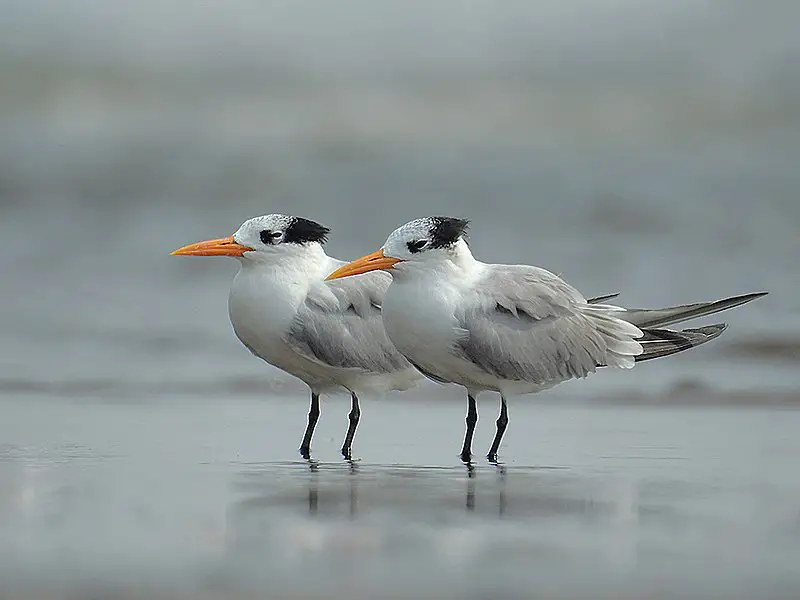
The lesser crested tern is a beautiful bird belonging to the Laridae family. It can be found breeding in subtropical coastal parts of the world, mainly from Red Sea across Indian Ocean.
Its genus name comes from Ancient Greek word Thalasseus which means fisherman and its specific bengalensis refers to Bengal, historically referring to much of northern India and Bangladesh.
The adult has white plumage with grey on wings and back; black cap extending behind eye; long pointed bill yellow tipped red at base, orange legs and feet.
They feed primarily by plunge-diving for fish near shore but may also take some insects or scavenge off boats or piers when given opportunity.
This species nests in colonies often on beaches or islands with other seabirds where it lays two eggs per clutch that are incubated for about a month before hatching.Scientific classification:
| Kingdom | Animalia |
| Phylum | Chordata |
| Class | Aves |
| Order | Charadriiformes |
| Family | Laridae |
| Genus | Thalasseus |
| Species | T. bengalensis |
Also Featured In: Beautiful Indonesian Birds, Common Birds of Maharashtra
5. Cuckoos
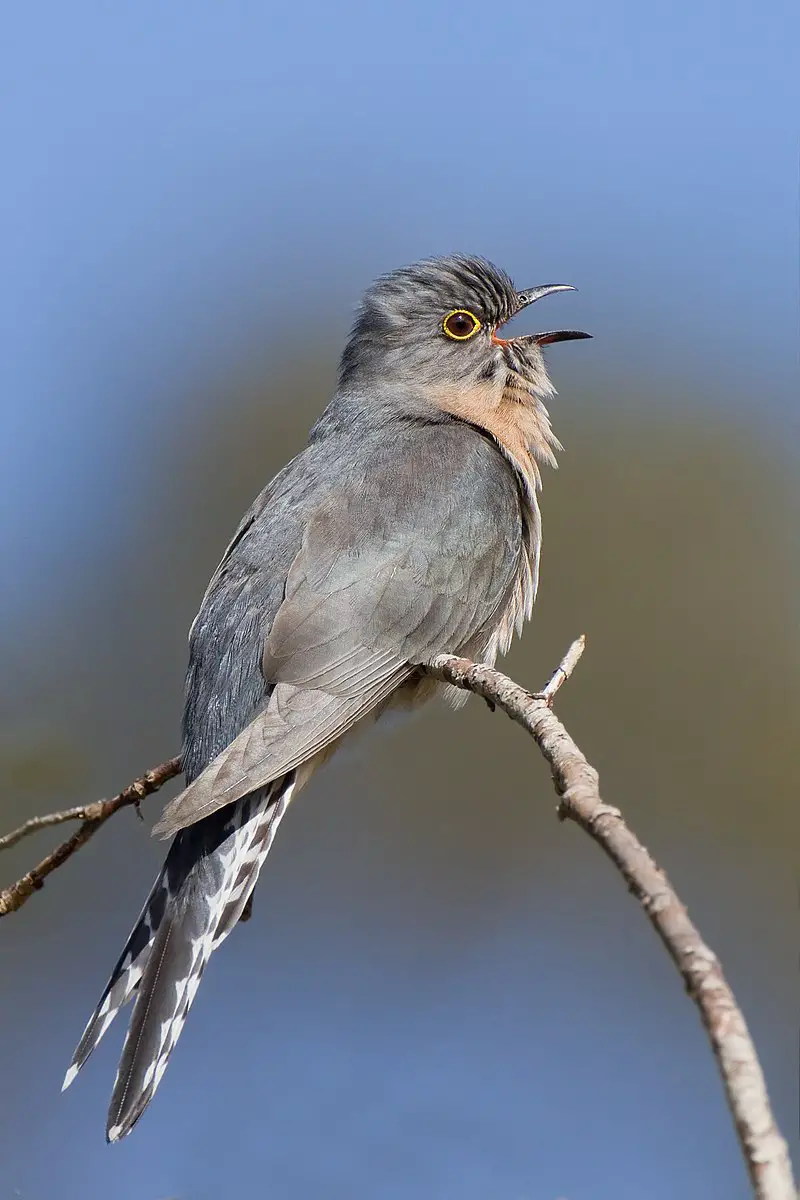
Cuckoos are fascinating birds belonging to the Cuculidae family, which is the only taxon in the order of Cuculiformes.
There are many different species within this family such as common or European cuckoo, roadrunners, koels, malkohas, couas and anis.
Some of these species may even be identified as separate families – Centropodidae and Crotophagidae respectively.
These birds have been known for their unique features such as loud calls heard consistently during certain times of day and night.
They also exhibit behavior like brood parasitism where they lay eggs in other nests so that their chicks can get more food from host parents than its own.
All these traits make them one-of-a-kind creatures worth admiring.Scientific classification:
| Kingdom | Animalia |
| Phylum | Chordata |
| Class | Aves |
| Clade | Otidimorphae |
| Order | Cuculiformes Wagler, 1830 |
| Family | Cuculidae Leach, 1820 |
Also Featured In: Most Common Types of Bangladeshi Birds, Birds of Sweden
6. White-Bellied Sea Eagle
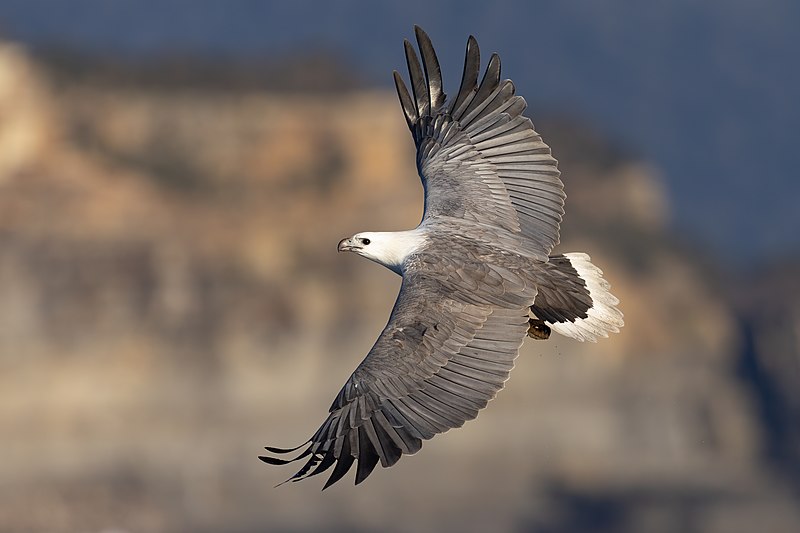
The White-bellied sea eagle is an impressive large bird of prey that belongs to the Accipitridae family.
It was first described by Johann Friedrich Gmelin in 1788 and it is closely related to Sanford’s sea eagle found in the Solomon Islands.
The adult white-bellied sea eagles have a stunning appearance with their white heads, dark brown bodies, and long wings which span up to 1.8 meters across.
They can be seen soaring above coastal areas searching for fish, reptiles or small birds as they hunt for food.
These majestic creatures are also known for being incredibly vocal when nesting – making loud cackling noises at dawn and dusk near riverside forests.Scientific classification:
| Kingdom | Animalia |
| Phylum | Chordata |
| Class | Aves |
| Order | Accipitriformes |
| Family | Accipitridae |
| Genus | Haliaeetus |
| Species | H. leucogaster |
Also Featured In: South Australian Birds, Birds of Tasmania
7. Brahminy Kite
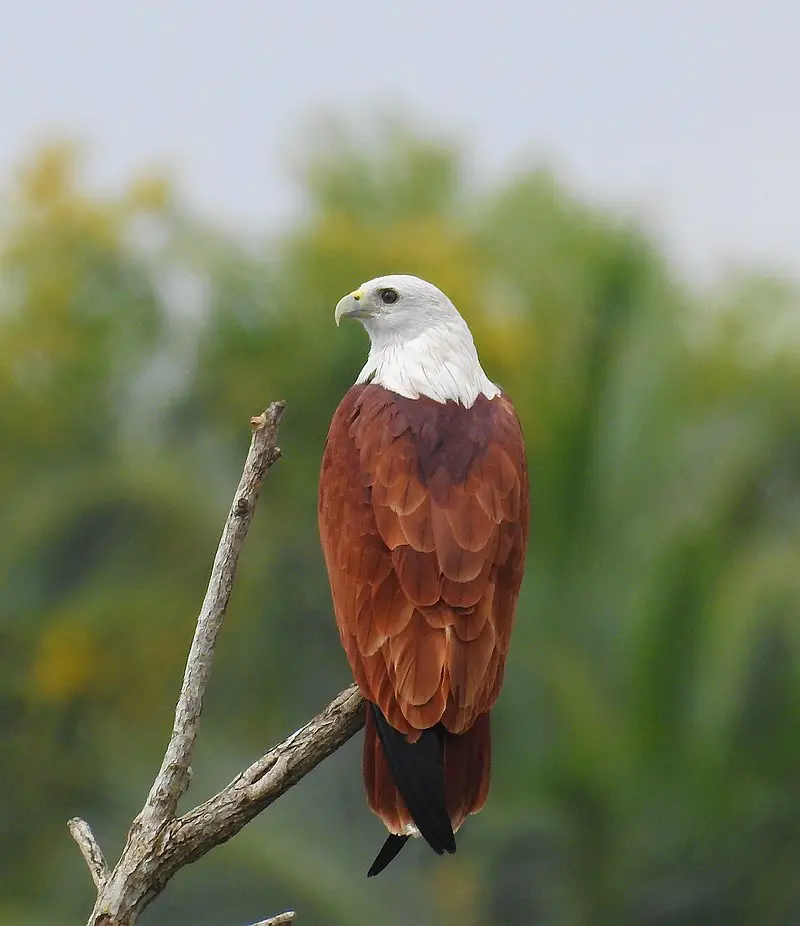
The Brahminy Kite is a majestic bird of prey native to the Indian subcontinent, Southeast Asia and Australia. It was formerly known as the red-backed sea eagle in Australia.
This medium-sized raptor has a distinctive white head with rufous brown feathers covering its body, making it easily recognisable from far away. The wingspan can reach up to 5 feet wide.
Brahminy kites are found mainly on coasts and inland wetlands where they feed mostly on dead fish or carrion left by other animals.
They also hunt for small mammals such as rodents or reptiles like lizards and snakes during dry spells when food sources become scarce.
These birds have adapted well over time and will even scavenge for food near picnic sites or urban areas if need be.
Overall these beautiful creatures are an important part of their local ecosystems which rely heavily upon them for keeping animal populations balanced through natural predation methods instead of manmade ones; this ensures that nature remains healthy so future generations may enjoy it too.Scientific classification:
| Kingdom | Animalia |
| Phylum | Chordata |
| Class | Aves |
| Order | Accipitriformes |
| Family | Accipitridae |
| Genus | Haliastur |
| Species | H. indus |
Also Featured In: Birds that Live around Brisbane, Birds that Charles Darwin Studied
8. White-Breasted Waterhen
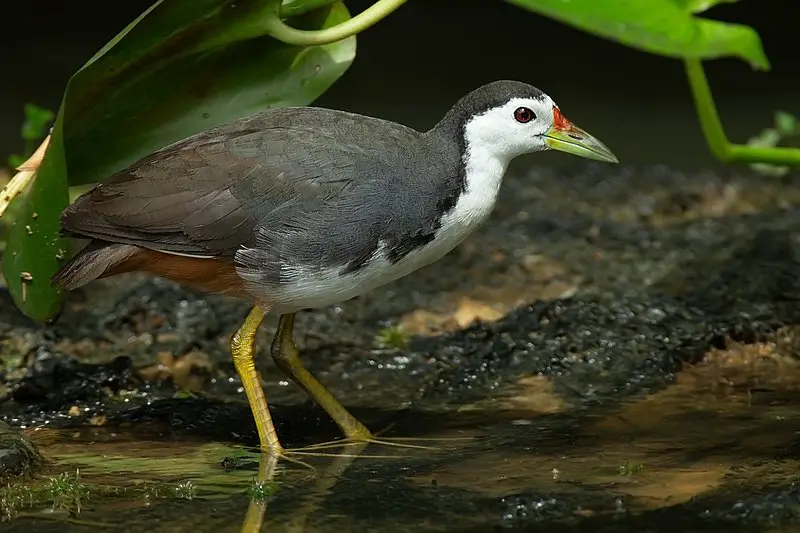
The White-breasted Waterhen is a stunning species of bird from South and Southeast Asia. It has a striking appearance, with its dark slaty plumage contrasted by the clean white of its face, breast and belly.
This bold waterbird can often be seen slowly walking around marshes or even drains near busy roads with its tail held upright in an unmistakable pose.
They are omnivores which feed on both plants and small animals such as insects and invertebrates.
The White-breasted Waterhen plays an important role in their ecosystems as they help to keep it balanced by consuming pests that could potentially cause damage to crops or other plant life if left unchecked.Scientific classification:
| Kingdom | Animalia |
| Phylum | Chordata |
| Class | Aves |
| Order | Gruiformes |
| Family | Rallidae |
| Genus | Amaurornis |
| Species | A. phoenicurus |
Also Featured In: Common Birds in Kerala, Common Birds in Bangalore
9. Black Drongo

The Black Drongo is a small passerine bird of the Dicruridae family, commonly found in tropical southern Asia from Iran through India and Bangladesh to Indonesia.
It has an all black plumage and distinctive forked tail measuring 28 cm long. This omnivorous species feeds on insects such as flies, bees, beetles and moths; it also consumes fruit juices during summer months.
The nest can be built anywhere including open fields or near houses made up of twigs with a cup-shaped inner lining using grasses & hair filled with feathers & cobwebs.
During breeding season they are known to perform aerial acrobatics while chasing away any intruders who come too close to their nests.Scientific classification:
| Kingdom | Animalia |
| Phylum | Chordata |
| Class | Aves |
| Order | Passeriformes |
| Family | Dicruridae |
| Genus | Dicrurus |
| Species | D. macrocercus |
Also Featured In: Asian Birds, Most Common Taiwan Birds
10. Brown Booby
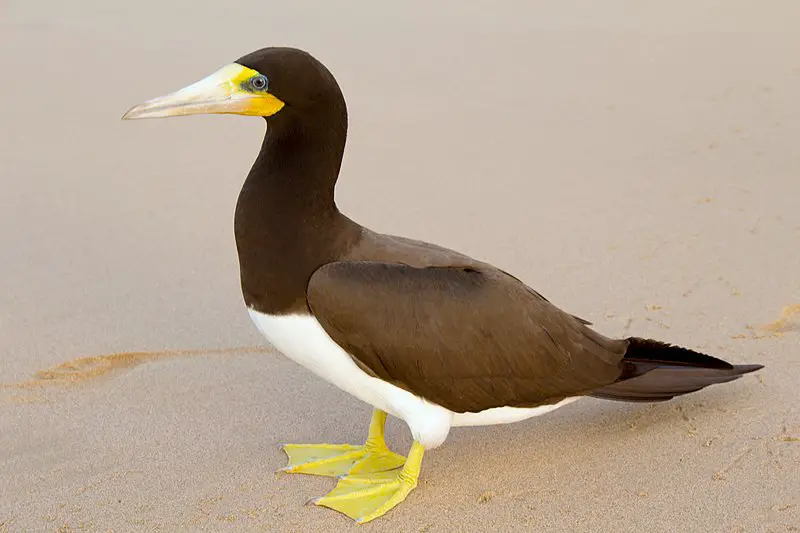
The Brown Booby is a large, seabird from the booby family Sulidae. It has a pantropical range and can be found in many areas of the world.
This bird lives in flocks and forages by plunging into shallow waters to catch small fish that are driven near the surface by predators or storms.
The brown booby is known for its short wings which make it highly maneuverable when hunting; this allows it to pursue prey quickly with sudden turns and dives.
Its diet also includes squid, crustaceans, eggs of other birds, as well as scraps from boats or ships they may come across while flying around coastlines.
They sometimes rest on floating objects during their long flights over open water between islands or continents.Scientific classification:
| Kingdom | Animalia |
| Phylum | Chordata |
| Class | Aves |
| Order | Suliformes |
| Family | Sulidae |
| Genus | Sula |
| Species | S. leucogaster |
Also Featured In: Egyptian Birds, Birds You’ll Find in the Sea
11. Common Sandpiper
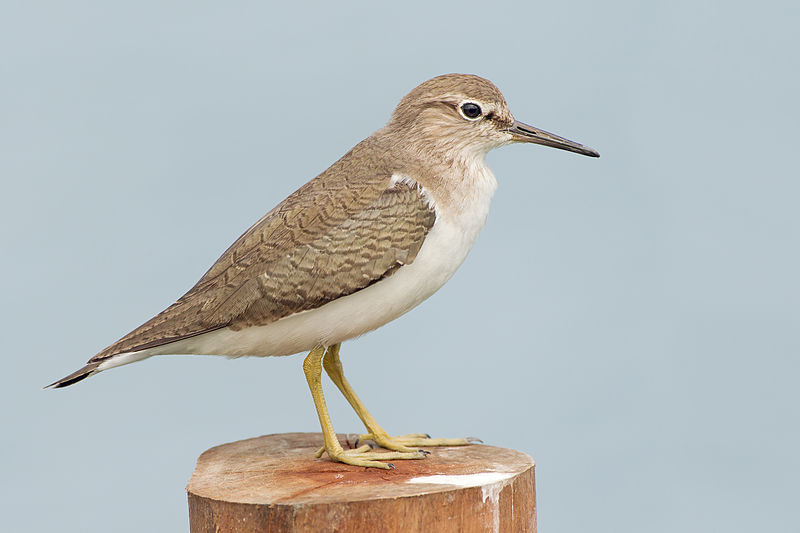
The Common sandpiper (Actitis hypoleucos) is a small Palearctic wader, found in Eurasia and parts of Africa. It can be identified by its brown back, white breast and distinctive black eye-stripe.
In flight it shows broad wings with white underparts and conspicuous dark patches on the upperwings.
These birds live close to water bodies such as rivers or lakes where they feed mainly on insects, crustaceans and molluscs which they find in mudflats.
They are also known to have hybridized with their American sister species – the Spotted Sandpiper (A macularia).
This bird is territorial during breeding season but forms flocks outside of this period when migrating long distances between wintering grounds throughout Europe, North Africa & South West Asia..Scientific classification:
| Kingdom | Animalia |
| Phylum | Chordata |
| Class | Aves |
| Order | Charadriiformes |
| Family | Scolopacidae |
| Genus | Actitis |
| Species | A. hypoleucos |
Also Featured In: Common Estonian Birds, Common Birds in London
12. Striated Heron
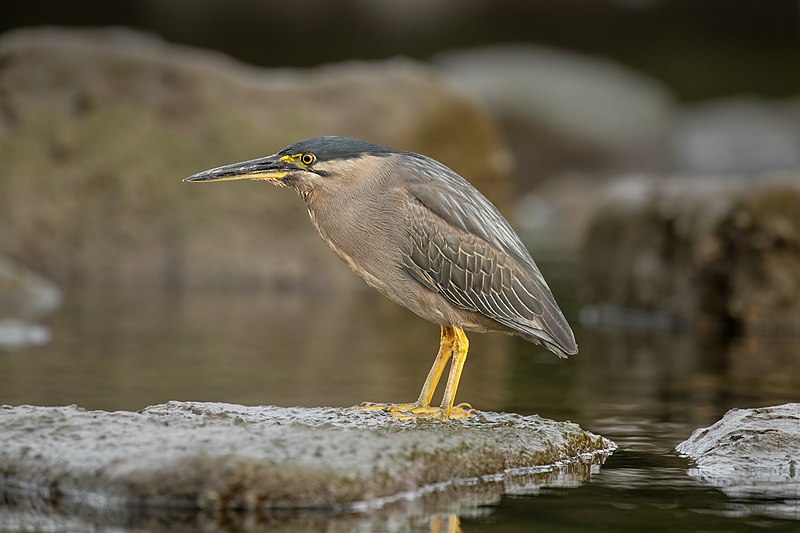
Striated herons are a small species of heron, measuring around 44cm tall. They can be found in wetland areas across the Old World tropics, from west Africa to Japan and Australia as well as South America and the Caribbean.
Striated herons have some interesting behavioral traits that make them unique; they’re mostly sedentary birds who tend to stay close to their breeding habitats throughout most of the year.
During breeding season these little green-backed herons become more active, often performing courtship dances in order to attract mates before nesting together on nearby trees or shrubs.Scientific classification:
| Kingdom | Animalia |
| Phylum | Chordata |
| Class | Aves |
| Order | Pelecaniformes |
| Family | Ardeidae |
| Genus | Butorides |
| Species | B. striata |
Also Featured In: Beautiful Malaysian birds, Rainforest Birds You Should Know
13. Macronus Gularis
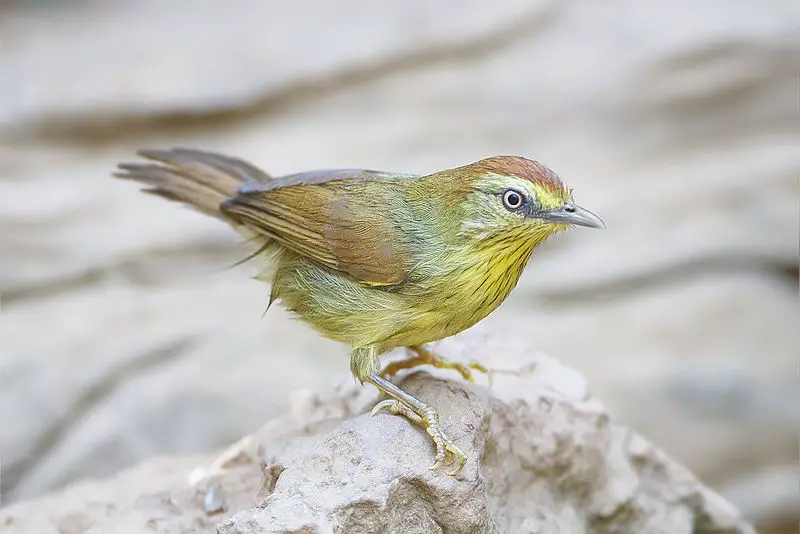
The Macronus gularis bird, commonly known as the Pin-Striped Tit-Babbler or Yellow-Breasted Babbler, is a species of Old World babbler found in South and Southeast Asia.
It was first described by American naturalist Thomas Horsfield in 1822 based on specimens collected from Sumatra.
The name ‘Macronus’ comes from the Greek words for “long” and “nose”, referring to its long beak.
They have brownish gray upperparts with paler underparts covered with bold black streaks along their sides and wings; they also have yellow throats which make them easily recognizable at a distance.
Macronus gularis are social birds that live in small groups of 3-10 individuals and communicate through loud calls such as chirps or trills but also use contact calls like whistles when separated from other members of their group.
Their diet consists mainly of insects, fruits, seeds, flowers buds – making them important pollinators.Scientific classification:
| Kingdom | Animalia |
| Phylum | Chordata |
| Class | Aves |
| Order | Passeriformes |
| Family | Timaliidae |
| Genus | Mixornis |
| Species | M. gularis |
Also Featured In: Common Birds Found in Nepal, Most Common Tripura Birds You Need to Know
14. Lesser Sand Plover
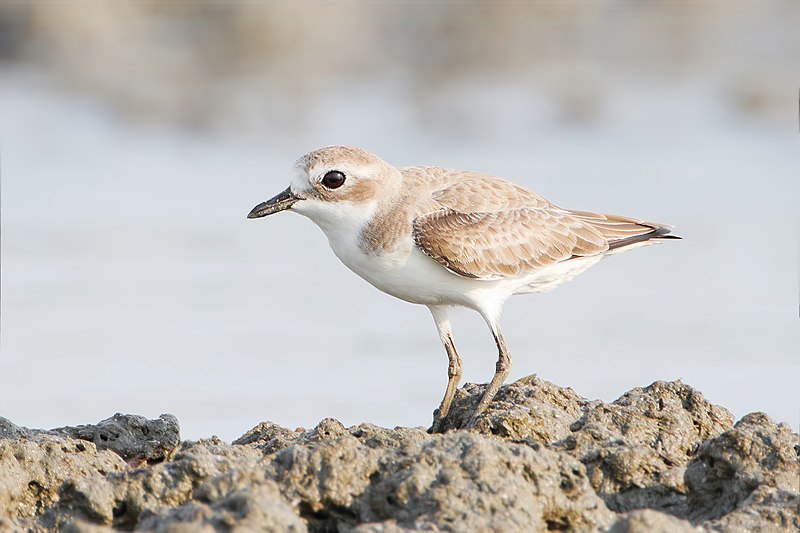
The Lesser Sand Plover is a small wader bird belonging to the plover family. It has yellowish-brown upperparts and white underparts, with a distinct black band across its chest and whitish forehead.
Its wings are short but powerful, allowing it to cover large distances in search of food such as insects, worms or crustaceans found on muddy beaches or shallow lagoons near coasts.
The species prefers habitats with low vegetation like sandy deserts, coastal dunes and salt flats where they can hide among the sand grains while foraging for food during their migrations between Africa and Asia.
These birds form monogamous pairs that breed annually in springtime; nests consist of scrapes made on the ground lined with pebbles or shells carefully arranged by both parents who will vigorously defend them against predators until chicks fledge after about four weeks from hatching.Scientific classification:
| Kingdom | Animalia |
| Phylum | Chordata |
| Class | Aves |
| Order | Charadriiformes |
| Family | Charadriidae |
| Genus | Charadrius |
| Species | C. mongolus |
Also Featured In: Kyrgyzstan Birds, Common Republic of Nauru Birds
15. Eurasian Whimbrel
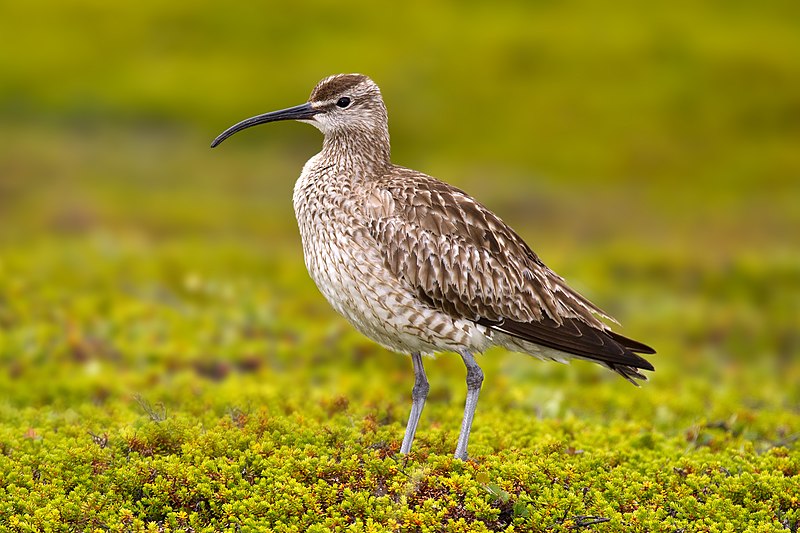
Eurasian Whimbrels are a species of wading bird commonly found in subarctic regions of Europe and Asia.
They have white rumps, long curved bills, brown wings and backs with light streaking on the lower breast.
These birds feed mainly on crustaceans, mollusks or worms they find while probing in the mud during low tide.
During breeding season they can be seen nesting near coastal areas or wetlands where food is plentiful.
This species has recently been split from Hudsonian whimbrels but some authorities still consider them to be one species due to their similarities which includes migration patterns as well as habitat preferences.
Eurasian whimbrels are an important part of many ecosystems because they help control insect populations by eating larvae before it can cause damage to crops or vegetation nearby.Scientific classification:
| Kingdom | Animalia |
| Phylum | Chordata |
| Class | Aves |
| Order | Charadriiformes |
| Family | Scolopacidae |
| Genus | Numenius |
| Species | N. phaeopus |
Also Featured In: Singapore Birds, Galapagos Birds You Should Know
16. Black-Naped Monarch
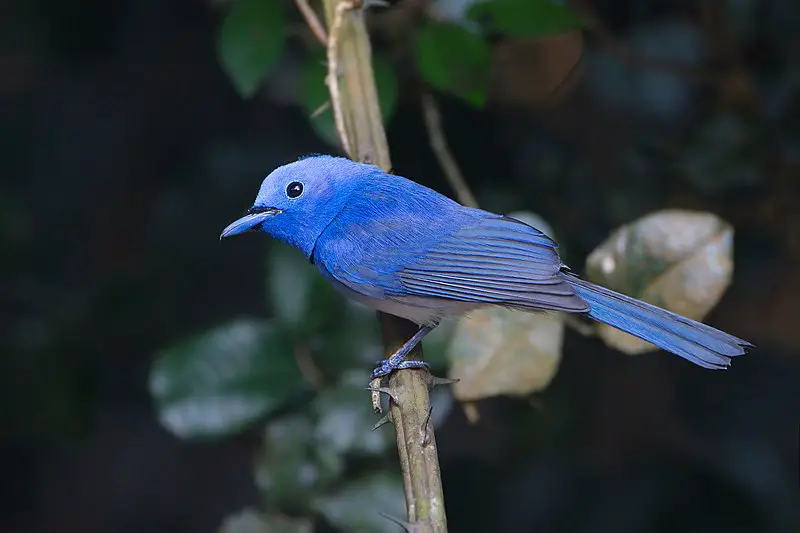
The Black-naped Monarch is a beautiful and agile passerine bird native to Southern and South East Asia.
With its distinct black patch on the back of it’s head, this small but strong species stands out among other birds in the area.
The male has vibrant blue plumage with an elegant narrow black half collar (“necklace”) which makes him even more attractive.
Females are comparatively duller with olive brown wings and light yellowish underparts which helps them blend into their environment better for camouflage purposes.
These birds feed mainly on insects, spiders and fruits making them beneficial as they help reduce pests while also providing nutrients to local vegetation by dispersing seeds from fruit consumption.Scientific classification:
| Kingdom | Animalia |
| Phylum | Chordata |
| Class | Aves |
| Order | Passeriformes |
| Family | Monarchidae |
| Genus | Hypothymis |
| Species | H. azurea |
Also Featured In: Gujarati Birds, Common Birds that Live in Odisha
17. Bridled Tern
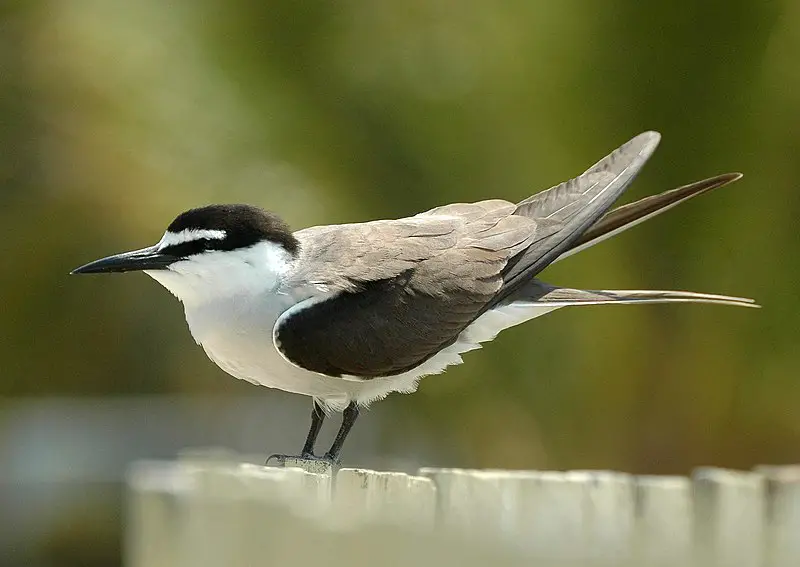
The Bridled Tern is a medium-sized seabird of the family Laridae, found in tropical oceans. It has an impressive wingspan of 77–81 cm and measures 30–32 cm in length – similar to that of the Common Tern.
Its scientific name originates from Ancient Greek; Onux meaning “claw” or “nail”, and Prion, which translates as “saw”. The specific anaethetus means ‘senseless’ or ‘stupid’.
These birds are elegant flyers with greyish brown upperparts and white underparts when they take off into flight, while their head appears black on top but turns to white below the eyes with a thin line between them.Scientific classification:
| Kingdom | Animalia |
| Phylum | Chordata |
| Class | Aves |
| Order | Charadriiformes |
| Family | Laridae |
| Genus | Onychoprion |
| Species | O. anaethetus |
Also Featured In: Oman Birds, British Virgin Islands Birds You Need to See
18. Greater Crested Tern
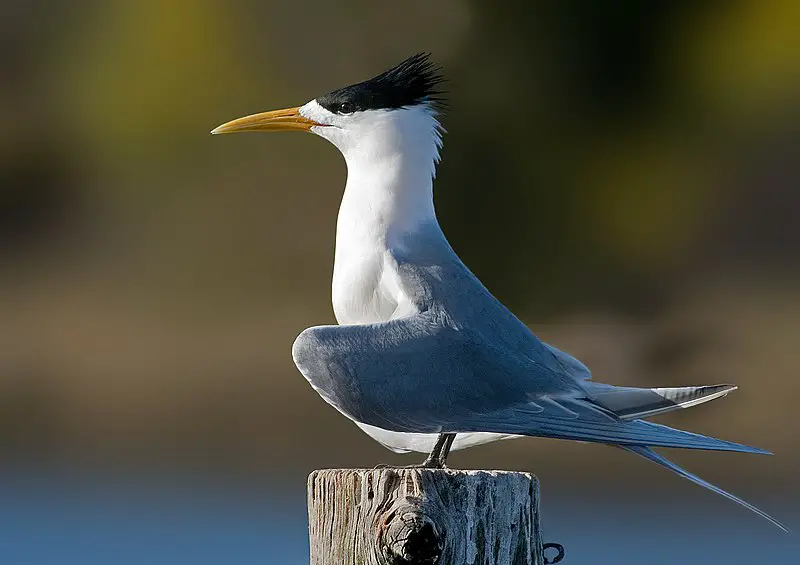
The Greater crested tern is a large bird of the family Laridae, found in tropical and subtropical regions across the Old World.
It has five subspecies which breed from South Africa to Australia, before migrating away for winter.
The distinctive crest feathers on its head give it its name and set it apart from other species like gulls or skuas.
They have wide wingspans that allow them to fly swiftly over oceans or coasts with ease – they are known as swift terns because of this.
The greater crested tern feeds mainly off fish caught at sea by plunge-diving into waters up to 10m deep; an impressive feat indeed.
With their bright white plumage, black caps and long yellow bills they stand out against any landscape – even on land these birds can be seen enjoying life along coastlines.Scientific classification:
| Kingdom | Animalia |
| Phylum | Chordata |
| Class | Aves |
| Order | Charadriiformes |
| Family | Laridae |
| Genus | Thalasseus |
| Species | T. bergii |
Also Featured In: Maldives birds, New South Wales Birds You Need to See
19. Christmas Frigatebird
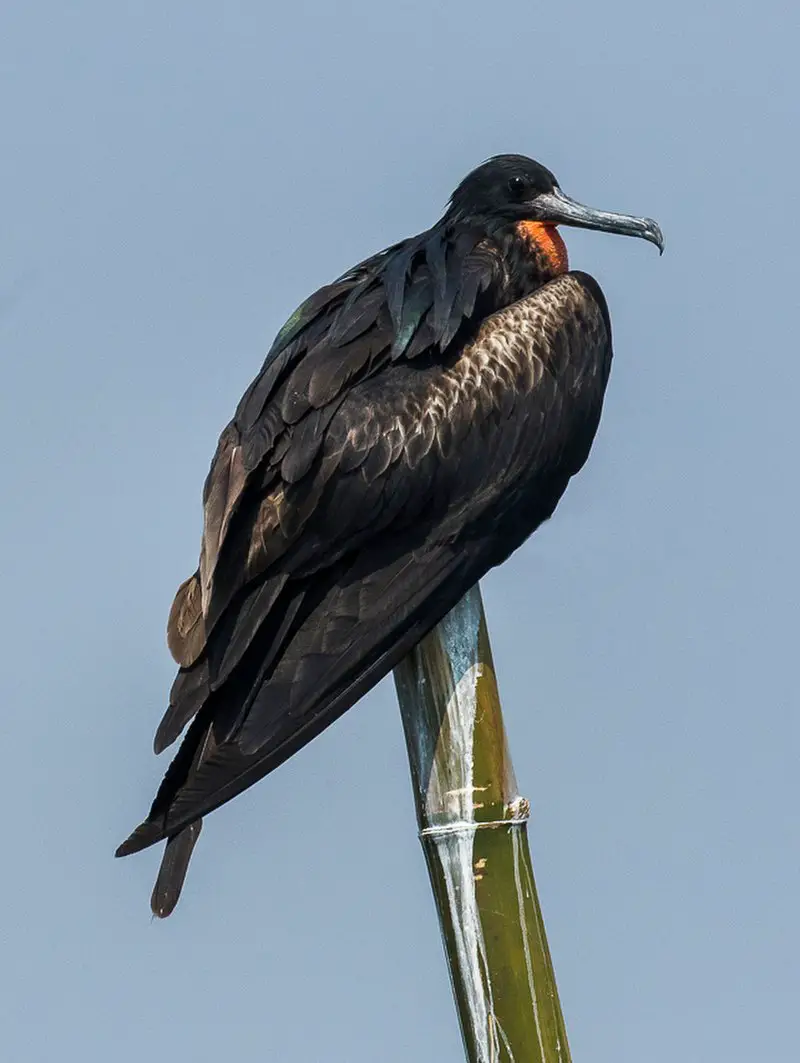
The Christmas frigatebird is a large seabird endemic to Christmas Island in the Indian Ocean.
It has an impressive wingspan of seven feet and brownish-black plumage, with long narrow wings and deeply forked tail.
The male possesses an egg shaped red gular pouch which it inflates during courtship displays.
This species can be seen soaring high into the air on thermals or gliding over open water while searching for food such as flying fish, squid, jellyfish and crustaceans.
During breeding season they form huge mixed colonies where their loud cackles often fill the sky.
Through conservation efforts this threatened species is making a comeback despite its vulnerability to habitat loss due to human activities like land development or fishing nets that may entangle them at sea.Scientific classification:
| Kingdom | Animalia |
| Phylum | Chordata |
| Class | Aves |
| Order | Suliformes |
| Family | Fregatidae |
| Genus | Fregata |
| Species | F. andrewsi |
Also Featured In: Christmas Island Birds, Birds of Karnataka
20. Javan Pond Heron
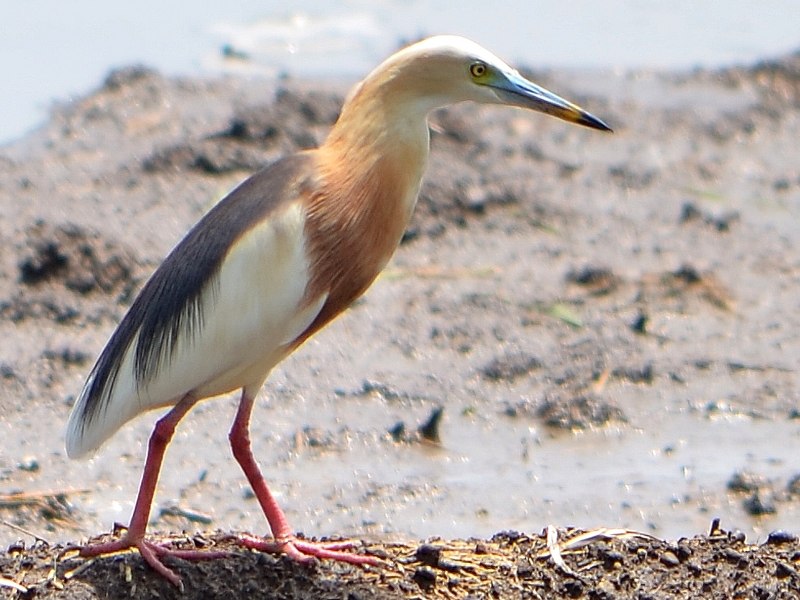
The Javan Pond Heron is a beautiful wading bird that can be found in shallow fresh and salt-water wetlands of Southeast Asia.
It has an overall orange, slaty and white colouring during mating season with yellow bill, black tip on its bill and yellow eyes.
Its length typically measures 45 cm long with white wings. The heron’s diet consists mainly of insects, fish, crabs as well as any other small creatures it may find along the shoreline or water bed where they live.
These birds are usually solitary but can also sometimes gather in groups to hunt for food at dusk when their prey are more active.
They use their keen vision to spot potential prey before quickly darting forward to catch them using their sharp bills.Scientific classification:
| Kingdom | Animalia |
| Phylum | Chordata |
| Class | Aves |
| Order | Pelecaniformes |
| Family | Ardeidae |
| Genus | Ardeola |
| Species | A. speciosa |
Also Featured In: Herons Species, Birds that Commonly Found in Bali
21. Greater Racket-Tailed Drongo
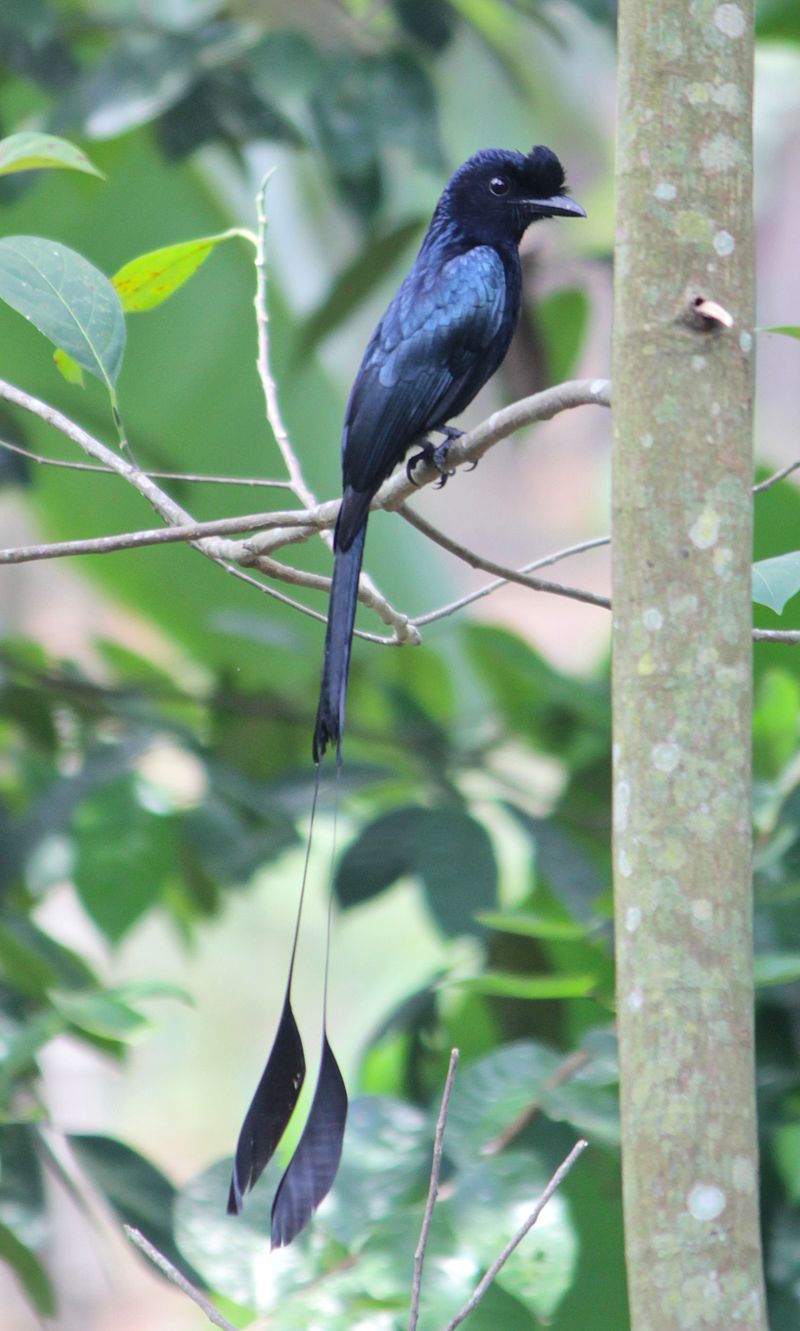
The Greater racket-tailed drongo is a medium-sized bird that inhabits forests in Asia. This bird is easily recognized by its elongated outer tail feathers which have webbing only at the tips.
The Greater racket-tailed drongo is part of the Dicruridae family, which also includes other types of drongos.
They are known for their conspicuous nature, often perching out in the open and using a variety of loud calls that include perfect mimicry of other birds and animals.
They are skilled at attracting attention, and can be seen flashing their long tails to intimidate predators or attract mates.
The Greater racket-tailed drongo is an important member of its ecosystem, helping to control insect populations and acting as a key prey species for predators.
Overall, this bird is a fascinating and important species of the Asian forests it inhabits.Scientific classification:
| Kingdom | Animalia |
| Phylum | Chordata |
| Class | Aves |
| Order | Passeriformes |
| Family | Dicruridae |
| Genus | Dicrurus |
| Species | D. paradiseus |
Also Featured In: Birds of Goa, Endemic Sri Lanka Birds
22. Black-Headed Bulbul
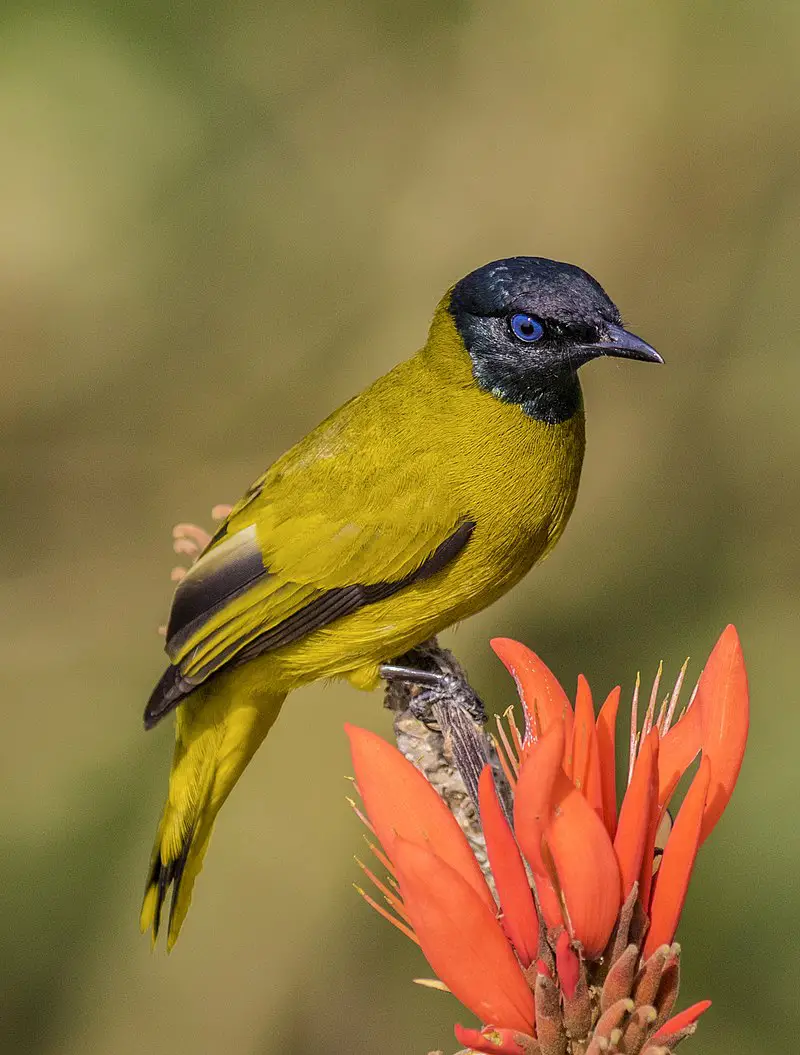
The black-headed bulbul is a bird belonging to the Pycnonotidae family. It can be found in forests across southeastern Asia.
Originally thought to be a member of the genus Turdus, it was later moved to Pycnonotus as Pycnonotus atriceps.
Recent research has shown that this genus is polyphyletic, leading to the creation of a new genus, Brachypodius, and the species being renamed Brachypodius melanocephalos.
This bird is easily recognizable due to its black head and yellow underparts. It feeds on fruit and insects, and is known for its sweet song.Scientific classification:
| Kingdom | Animalia |
| Phylum | Chordata |
| Class | Aves |
| Order | Passeriformes |
| Family | Pycnonotidae |
| Genus | Brachypodius |
| Species | B. melanocephalos |
Also Featured In: Birds that Live in Kuala Lumpur, Native Birds Of Ko Chang District
23. Orange-Breasted Trogon
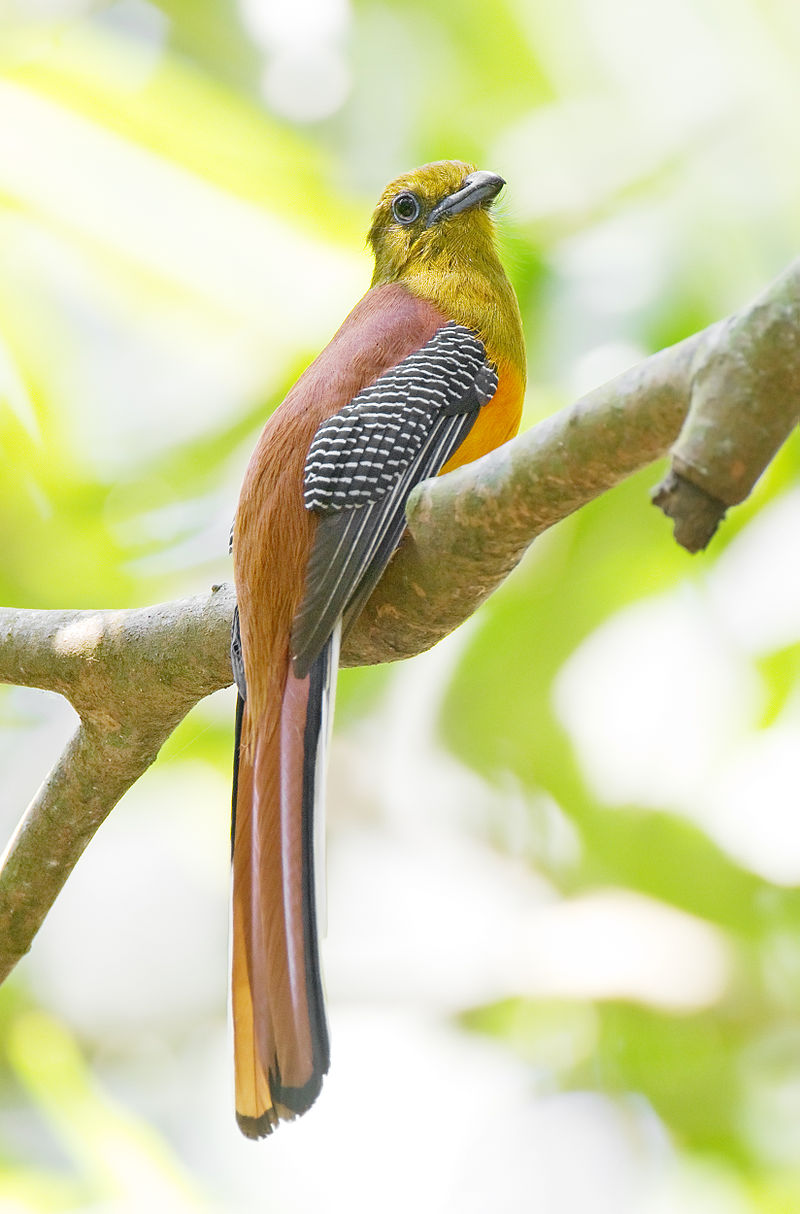
The Orange-breasted trogon is a stunning bird found in southern China, southeast Asia, Borneo, Sumatra, and Java. This sedentary species lives in the lower canopy of lowland forests, and it’s well-known for its colorful appearance.
It mainly feeds on insects from a perch and breeds between January to May. During this time, it excavates its nest into dead tree stumps. Both parents take an active role in caring for their young.
The Orange-breasted trogon is one of the most striking birds in its range and is a true pleasure to observe in the wild.Scientific classification:
| Kingdom | Animalia |
| Phylum | Chordata |
| Class | Aves |
| Order | Trogoniformes |
| Family | Trogonidae |
| Genus | Harpactes |
| Species | H. oreskios |
Also Featured In: Birds of Khao Yai National Park,
24. Indochinese Roller
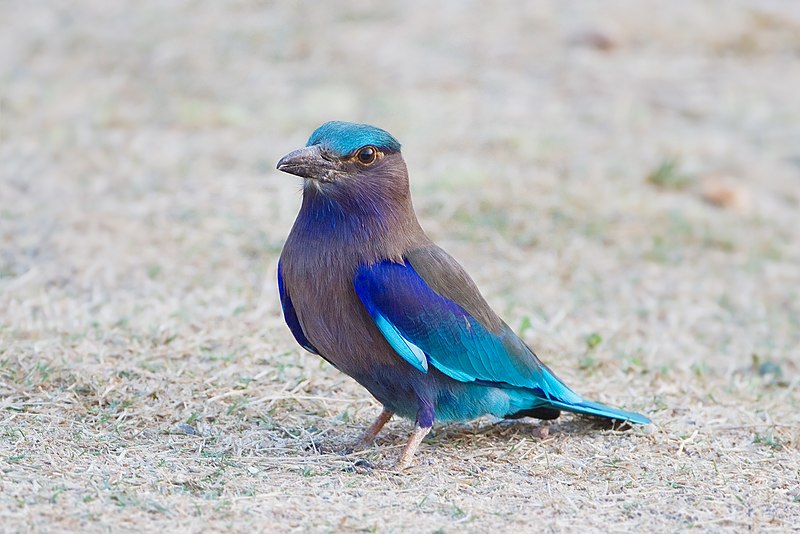
The Indochinese roller, also known as the Burmese roller, is a colorful bird that belongs to the roller bird family. It can be found in Eastern India, Myanmar, and Southeast Asia.
This bird is listed as Least Concern on the IUCN Red List, so it is not in danger of extinction. The American naturalist Thomas Horsfield described the Indochinese roller in 1840 and named it Coracias affinis.
Its striking plumage features shades of blue, green, and brown, with a distinctive crown of feathers on its head. As a roller bird, the Indochinese roller is known for its unique acrobatic dives and rolls during flight.
Overall, this beautiful bird is an important part of the ecosystem in its range and a delight to observe for bird enthusiasts.Scientific classification:
| Kingdom | Animalia |
| Phylum | Chordata |
| Class | Aves |
| Order | Coraciiformes |
| Family | Coraciidae |
| Genus | Coracias |
| Species | C. affinis |